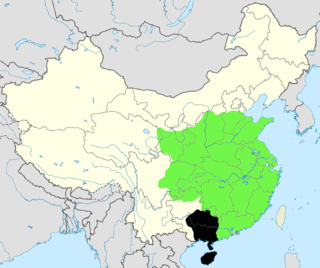
The Five Dynasties and Ten Kingdoms period was an era of political upheaval and division from 907 to 979. Five dynastic states quickly succeeded one another in the Central Plain, and more than a dozen concurrent dynastic states, collectively known as the Ten Kingdoms, were established elsewhere, mainly in South China. It was a prolonged period of multiple political divisions in Chinese imperial history.

Fujian is a province on the southeastern coast of China. Fujian is bordered by Zhejiang to the north, Jiangxi to the west, Guangdong to the south, and the Taiwan Strait to the east. Its capital is Fuzhou, while its largest city by population is Quanzhou, both located near the coast of the Taiwan Strait in the east of the province.

A commandery was a historical administrative division of China that was in use from the Eastern Zhou until the early Tang dynasty. Several neighboring countries adopted Chinese commanderies as the basis for their own administrative divisions.

Wuyue was a dynastic state of China and one of the Ten Kingdoms during the Five Dynasties and Ten Kingdoms period of Chinese history. It was ruled by the Qian clan of Haiyan (海鹽錢氏), whose family name remains widespread in the kingdom's former territory.

Qingyuan Jiedushi was a military/governance administrative unit (circuit) late in China's Five Dynasties and Ten Kingdoms Period, later renamed to Pinghai Jiedushi (平海節度使). It was an office created in 949 by Southern Tang's second emperor Li Jing for the warlord Liu Congxiao, who nominally submitted to him but controlled Quan and Zhang Prefectures in de facto independence from the Southern Tang state. Starting in 960, in addition to being nominally submissive to Southern Tang, the Qingyuan Circuit was also nominally submissive to the Song, which had itself become Southern Tang's nominal overlord.

Huang Chao was a Chinese rebel, best known for leading a major rebellion that severely weakened the Tang dynasty.
Jianzhou or Jian Prefecture (建州) was a zhou (prefecture) in imperial China centering on modern Jian'ou, Fujian, China. It existed (intermittently) from 621 to 1162.
Wang Chao (王潮), courtesy name Xinchen (信臣), formally Duke Guangwu of Qin (秦廣武公), was a warlord of the Chinese Tang dynasty, who controlled Fujian Circuit, eventually establishing the base of power for his family members to later establish the Five Dynasties and Ten Kingdoms period state Min.
Chen Yan was a Chinese warlord in Fujian during the late Tang dynasty. He served as governor of the Fujian Circuit, headquartered in what is now Fuzhou.

Jiangnan Circuit or Jiangnan Province was one of the major circuits during the Tang dynasty, Five Dynasties period, and early Song dynasty. During the Tang dynasty it was known as Jiangnan Dao (江南道), and during the Song dynasty Jiangnan Lu (江南路), but both dao and lu can be translated as "circuit". In 1020 it was divided into 2 circuits: Jiangnan East Circuit and Jiangnan West Circuit.

The Yuan dynasty was a Mongol-led imperial Chinese dynasty. During its existence, its territory was divided into the Central Region (腹裏) governed by the Central Secretariat and places under control of various provinces (行省) or Branch Secretariats (行中書省), as well as the region under the Bureau of Buddhist and Tibetan Affairs. In addition, the Yuan emperors held nominal suzerainty over the western Mongol khanates, but in reality none of them were governed by the Yuan dynasty due to the division of the Mongol Empire.
Hebei Circuit or Hebei Province was one of the major circuits during the Tang dynasty, Five Dynasties period, and early Song dynasty. During the Tang dynasty it was known as Hebei Dao (河北道), and during the Song dynasty Hebei Lu (河北路), but both dao and lu can be translated as "circuit". In 1042 it was divided into two circuits: Hebei East Circuit and Hebei West Circuit.

Liangzhe Circuit (997–1160s) was one of the major circuits during the Song dynasty (960–1279). Its administrative area corresponds roughly to modern Zhejiang, Shanghai, and southern Jiangsu. The fertile Yangtze River Delta lay within Liangzhe Circuit, as did Lake Tai. Liangzhe was the wealthiest circuit in Song.
Huainan Circuit or Huainan Province was one of the major circuits during the Tang dynasty, Five Dynasties period, and early Song dynasty. Huainan was also the name of Wu, whose territorial claims was nearly identical to the circuit. In 1072 during the Song dynasty it was divided into 2 circuits: Huainan East Circuit and Huainan West Circuit.

Guangnan East Circuit or Guangnan East Province was one of the major circuits during the Song dynasty. Its administrative area corresponds to roughly the modern Chinese province of Guangdong.

Guangnan West Circuit or Guangnan West Province was one of the major circuits during the Song dynasty. Its administrative area corresponds to roughly the modern provinces of Guangxi and Hainan, as well as the western part of Guangdong.

Jinghu South Circuit or Jinghu South Province was one of the circuits during the Song dynasty. Its administrative area corresponds roughly to the modern province of Hunan.

Jinghu North Circuit or Jinghu North Province was one of the circuits during the Song dynasty. Its administrative area corresponds to roughly the modern province of Hunan.
Xinghua Prefecture (興化軍府) was a Song dynasty military prefecture created in 979, under the administration of Fujian Circuit. It was abolished by the Mongol Yuan dynasty in 1277.
Wu Cheng (吳程), courtesy name Zhengchen (正臣), was a politician of the Chinese Five Dynasties and Ten Kingdoms Period state Wuyue, serving as a chancellor during the reign of its last two kings, Qian Hongzong and Qian Chu.













